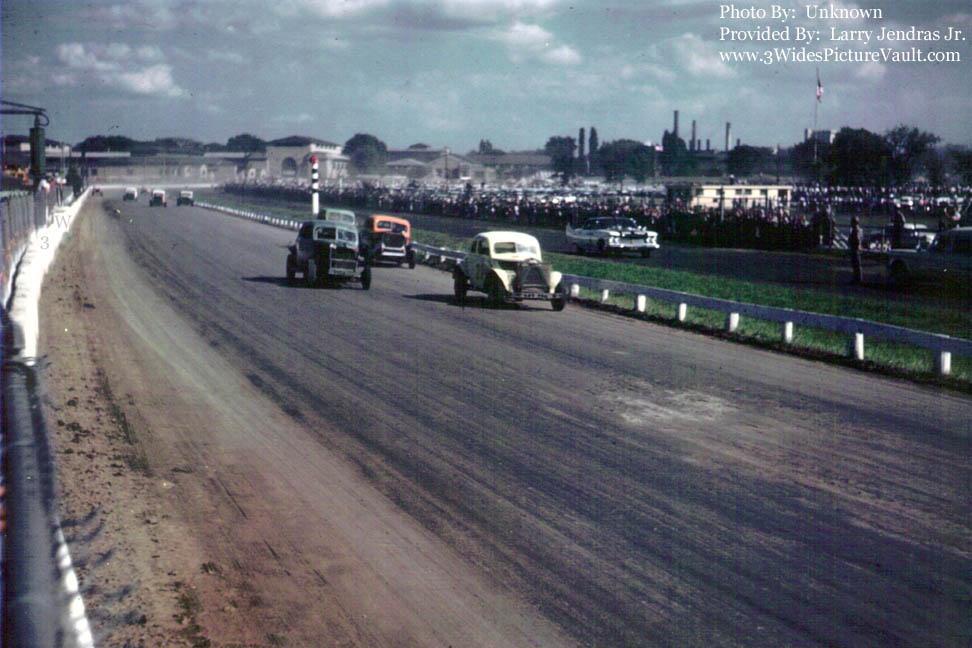
DO NOT PRINT, POST OR PUBLISH IMAGES APPEARING IN THE VAULT WITHOUT PERMISSION FROM PHOTOGRAPHER/PHOTOGRAPHER'S FAMILY OR PROVIDER

| Photo ID # | H09.28.11_FRT_STR_SYR_0060S_1 |
| Car #: | NA |
| Driver (s) : | Unknown |
| Location: | New York State Fairgrounds (Syracuse, N.Y.) |
| Date: | 1960 |
| Photographer: | Unknown |
| Photo provided by: | Larry Jendras Jr. |
| Comments: |
Senior Moment From Larry
Jendras Jr: Ever since 1972 when the first SuperDirt week was presented and the #00 of Buzzie Reutimann took the win, we think of Syracuse, N.Y. and the New York State Fairgrounds as a October tradition the early part of October. But the Sportsman Modified history there goes way back to 1949 when Labor Day races were held on the big 1 mile dirt track. Maryland's own Ralph Smith even won one in 1955 in the #88. I thought this photo was interesting since it showed full bodied coupes racing down that long backstretch. Relying on Gary Spaid's great book, Syracuse Scrapbook, the 1960 race was won by Cliff Kotary. All drivers in the field that day were from New York state. He and the white coupe would dominate the early 60's winning on Labor Day from 1960 through 1965. |
| Visitor's Comments | To add your comments about THIS PHOTO - Click Here | |
| Date: | Visitor's Name: | Comment: |
| 09.30.11 | Bill K | In the late 50's my friends and I
would stand at the fence in the infield, at the beginning of the
backstretch. You couldn't see much of the track, but it was neat seeing the
cars roar by up close. The open competition field was made up mostly of
NASCAR Sportsman which were running at several NY tracks at that time, and
Oswego Modifieds with a few "outsiders" showing up as well. 1960 was the beginning of the flathead era at the fair. They were kind of slow and clunky compared to the overheads (except for Cliff Kotary who won every year) . That lasted until 1967 when overheads were allowed again. Note the State Police cruiser on the cinder track. At that time the state actually ran and directed the races at the fair and the State Police acted as course safety marshals. Every time a car spun or hit the wall, several cruisers, always carrying 4 or 5 troopers and somebody's 11 year old nephew or son, would roar by on the cinder track to converge on the accident and direct the clean up. NY State control of the races ended after the infamous 1970 Labor Day event, probably the worst run, worst officiated race ever run anywhere, and the Glenn Donnelly era began soon afterward, for which we should all be thankful. |
| 09.30.11 | Terry Fick | The Senior Moment pic of Syracuse for some
reason made me think of all the safety innovations Lindy Vicari introduced.
I would bet the cars in the pic had working doors held shut for racing by a
rope or belt, maybe even tape or mechanics wire. Naturally the cage did not
interfere with access through the door, the thought in those days was not
side impact but escape from a burning car. Lindy was one of the first to require bolted or welded doors. He also always had the Goodwill Fire Company in the infield along with an ambulance from Bellvue Ave the name of which I can not remember (maybe Central, my parents were members which meant free rides). Lindy also put concrete retaining walls, 18 inches thick and at least as high as the lower window ledge of the cars all the way around the track (the expense of which might have been a contributing factor in his failure at Nazareth National). To this day there are many tracks without walls or with armco barriers, a barrier I hated as a driver; always thought about Doug Reid at BIR who went between the rails with the top rail stopping where a barber would put his razor for a shave. Concrete is a hard hit (experience tells me so) but I'd rather suffer racetrack rheumatism than decapitation. Today we take safety for granted at the racetrack, even the drivers. Just look at a sprint car, how many fume guards or full lower body panels do you see. Look at the header outlet. Can you see the lap belt? The heat from the exhaust must compromise the belt webbing, still, the added weight is not welcome. Thankfully, there are rules. Many drivers owe their very lives to rules they tried to circumvent. When I tell people here in the land of the intellectually enlightened that the NJ State Police, for all intents and purposes, sanction modified racing I get odd looks. But I can still remember the state cops coming through the Bridgeport pits with that magnetic thing with which they checked tubing wall thickness. I can also remember the teams sent home. It was good they sent a lot of cops. Even better .090 was required around the driver. I have no idea why I thought of the safety thing. For what it's worth. |
| 09.30.11 | 3Wide | Well Terry, I wasn't sure where to put your post either, but when you look at cars from back in the day it's hard to not think about what daredevils these guys were. It's easy to look back 50 years and say, "What were they thinking..." They challenge has always been to look at the racecar of the day and say "what are we thinking?" Soft walls, Hans Device, Full Seat containment.... Did we really have to wait until till the last decade to figure it out??? Seems so simple now. |
|